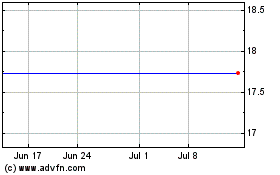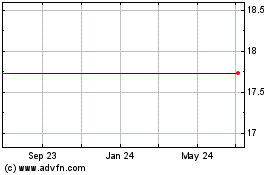By Bradley Olson and Erin Ailworth
Apache Corp. said it has discovered the equivalent of at least
two billion barrels of oil in a new west Texas field that has the
promise to become one of the biggest energy finds of the past
decade.
The discovery, which Apache is calling "Alpine High," is in an
area near the Davis Mountains that had been overlooked by
geologists and engineers, who believed it would be a poor fit for
hydraulic fracturing. It could be worth $8 billion by conservative
estimates, or even 10 times more, according to the company. Shares
rose by as much as 13% after U.S. markets opened Wednesday.
Apache started acquiring mineral rights in the area two years
ago and subsequently discovered its potential. The company then
quietly went about locking up more land in the field, believed to
be up to 450,000 acres overall. Its position now exceeds 300,000
acres, or roughly two-thirds of the field, and is about 20 times
the size of Manhattan.
The company has begun drilling in the area and says the early
wells, which produce more natural gas than oil, are capable of
providing at least a 30% profit margin at today's prices, including
all costs associated with drilling.
Some are so prolific that they can break even at a price of 10
cents per million British thermal units, according to the company.
Natural gas futures closed Tuesday at $2.72.
"This is a giant onion that is going to take us years to unveil
and peel back," Apache Chief Executive John Christmann IV said in
an interview. "The industry dogma about this area, all the
fundamental premises that most people had about it, were just
wrong."
It remains to be seen whether Alpine High delivers on its
potential; some oil and gas discoveries touted as game-changers
have historically produced less than advertised. Some analysts said
they were concerned about the need for infrastructure in West Texas
to process and ship gas, oil and other products from the
discovery.
"They are close to the Gulf Coast and to Mexico, where there
will be significant demand growth, but this could be big enough
that they could see price realization problems," said R.T. Dukes,
an analyst at energy consultancy Wood Mackenzie.
Still, the field, which Apache estimates could hold the
oil-and-gas equivalent of as much as 8.1 billion barrels of oil,
underscores the potential of new drilling methods to unlock vast
new resources in North America.
The discovery is likely to transform Apache, currently the
nation's sixth-largest independent energy company with a market
capitalization of $20.1 billion. Alpine High may now be the biggest
asset for Apache, known in the industry for its frugality and
record of buying assets from other companies rather than finding
its own.
The company is planning to direct one-fourth of its capital
budget this year toward the field, but will require several years
to ramp up production because of the need for pipelines and
processing equipment. Apache has so far drilled 19 wells in the
area.
The discovery of Alpine High in a previously sleepy corner of
Permian Basin comes as the industry has struggled globally to find
new resources, particularly oil. Other major discoveries in the
past decade include Exxon Mobil Corp.'s Liza field in Guyana, which
could hold as much as 1.4 billion barrels.
The new play is a short distance from extensive drilling
operations and is likely to stoke the speculative fever that has
recently engulfed the Permian, a vast swath of geology in West
Texas and New Mexico that has been gushing oil and gas for almost
100 years. The Permian has become popular again because producers
have found ways to use newer technologies to extract oil from the
area at a profit, even at current below-$50-a-barrel prices.
On Tuesday, EOG Resources Inc. announced plans to buy Yates
Petroleum Corp. for $2.5 billion including debt to extend its
holdings in the area. Private-equity firms and companies have been
scooping up land in the region at a price of $20,000 to $30,000 an
acre, even as the industry is mired in the worst price crash in
generations.
Apache by contrast says it bought into the new field it
discovered for about $1,300 an acre.
It may be years before the full value of the discovery shows up
on Apache's balance sheet, if it does at all. In 2009, Occidental
Petroleum Corp. trumpeted a new discovery in California that an
analyst later said could hold as many as 10 billion barrels. The
company never fully developed the resource and later spun off its
California operations.
But if it holds true, Apache's discovery would be the latest oil
and gas find to turn conventional geological wisdom on its
head.
Although the area in question, Texas' Reeves County, is heavily
drilled, most producers are focused farther north. For years, it
was assumed that the layers in Alpine High would be too full of
clay, which impedes hydraulic fracturing, the process of blasting
sand and water into brittle rock layers to make oil and gas flow
out.
Prior explorers drilled more than 110 dry holes in the area.
However, a team of explorers led by Steven Keenan, whom Apache
hired from EOG in 2014, studied the geology and hydrocarbons in the
region of the Alpine High acreage and concluded that it might have
undiscovered potential.
"Every 10 years or so, there's a so-called new discovery, and
generally they confound the prevailing wisdom," said Mr. Keenan, in
an interview.
Mr. Keenan was previously part of the team that helped EOG
understand the potential of another new field: the Eagle Ford in
South Texas. It now produces more than 1 million barrels a day.
Write to Bradley Olson at Bradley.Olson@wsj.com and Erin
Ailworth at Erin.Ailworth@wsj.com-
(END) Dow Jones Newswires
September 07, 2016 10:58 ET (14:58 GMT)
Copyright (c) 2016 Dow Jones & Company, Inc.
Apache (NYSE:APA)
Historical Stock Chart
From Mar 2024 to Apr 2024

Apache (NYSE:APA)
Historical Stock Chart
From Apr 2023 to Apr 2024
